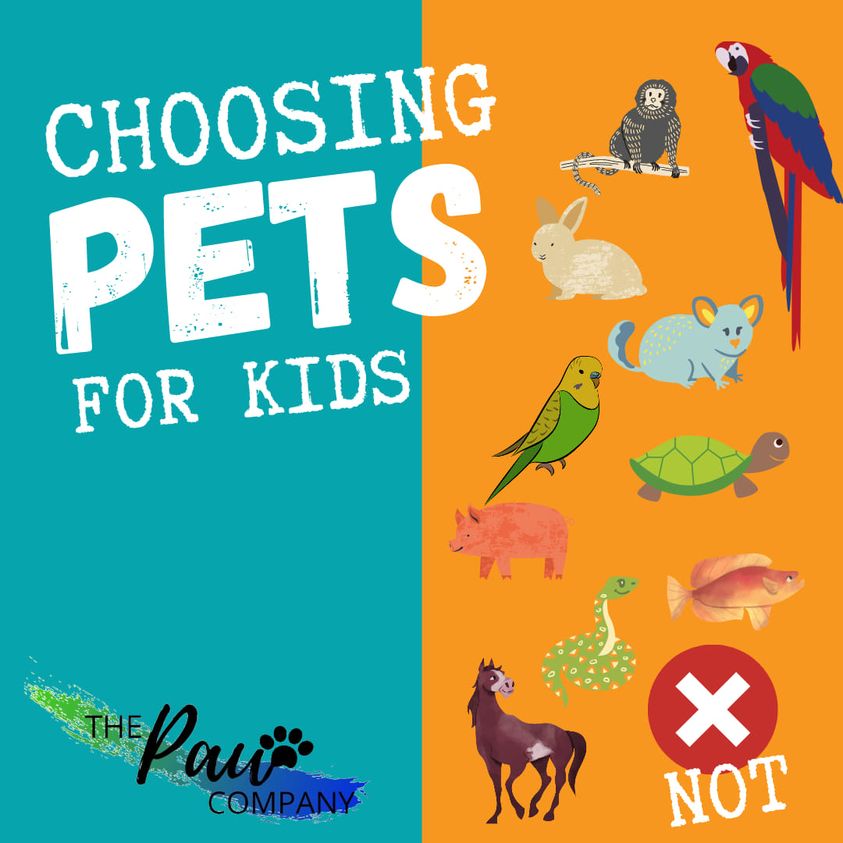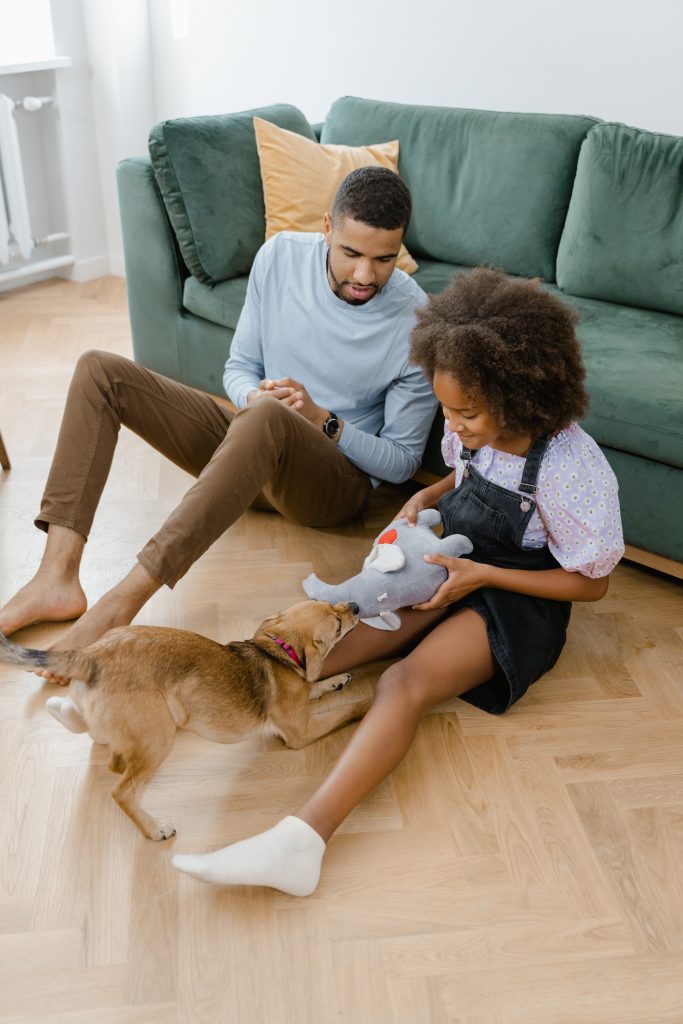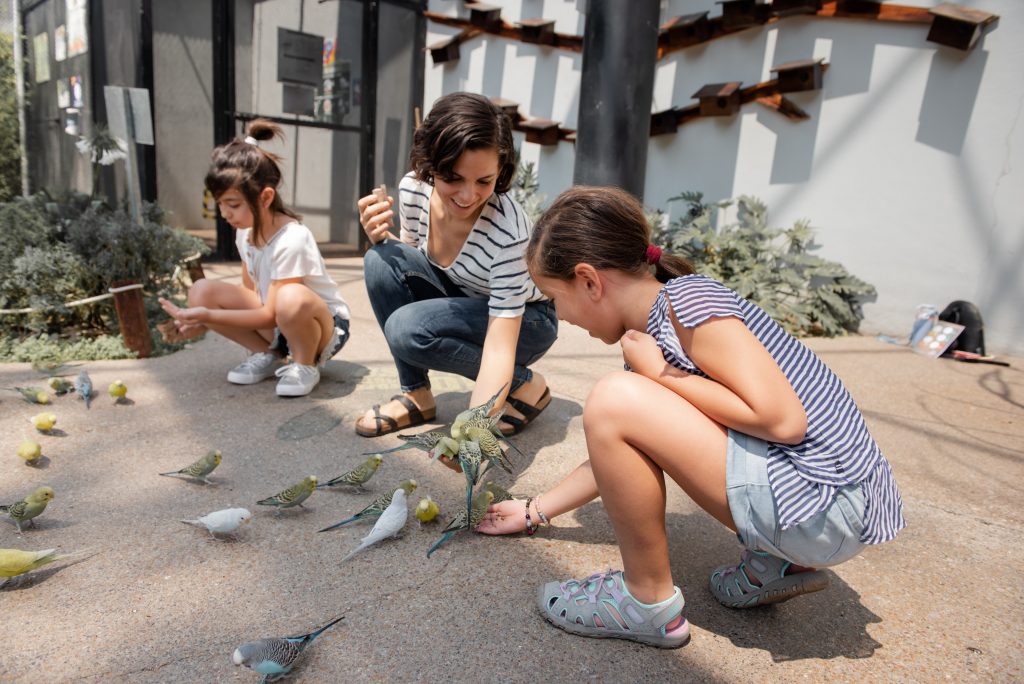
ANIMALS 101 – CHOOSING A PET FOR YOUR CHILD IS A BIG DECISION AND NOT ONE TO BE TAKEN LIGHTLY!
Research shows that pets can contribute to a child’s development physically, by strengthening their immune system, and emotionally by creating an irreplaceable relationship. It is a great way to learn responsibility and compassion, however, it should never be at the expense of an animal and parents should be very involved in the care.

For many reasons, we discourage keeping wild/exotic animals as pets.
CHOOSING TO GET A PET
There are many factors to take into account including, but not limited to:
Your lifestyle. Do you have time to meet the needs of this animal? Children with busy schedules and families who travel a lot can’t spend enough time with their pets.
Your energy levels. If you are not very active, then getting a high-energy dog like a Border Collie or Jack Russell is a no-go.
Your resources. Most animals are very expensive to take care of and if you can’t afford veterinary visits, proper food etc., then please do not let the animal pay the price. This includes vaccination, deworming, annual check-ups, microchip STERILISATION etc.
Your commitment. Most of the time it is at least a 10 to 15-year commitment. If you are really committed, you will also do proper research about their needs before you decide on a pet. Are you willing to work on behaviour issues if they occur instead of just giving the pet away?
Your yard. All animals, including cats, should be kept safe in your yard. You need enough space for the animal to run and play. Small yards do not equal small dogs automatically!
OTHER FACTORS
- Some pets are much noisier, messier, or need lots of attention.
- Some need social mates of a similar species and some are more solitary and some should not be kept with a particular other species.
- Some get stressed or depressed easily.
- Some have sensitive digestive systems, are prone to specific health conditions, and are sensitive to household chemicals or even items like candles, cookware, etc.
- You might need a permit to have this animal, which may differ between provinces.
- If a child or parent is scared of the particular specie, it could have a detrimental effect on the animal and the humans, for life.
- Not all vets are experts on all types of animals especially exotic pets! Do you have a vet close by for this particular pet?
- You need a plan for your pet in your will or in case of an emergency.

CHOOSING A PET FOR YOUR CHILD (C-C-C)
COMPATIBILITY. Some people are cat people and some are dog people. You need to choose a pet for your specific child. The behaviour of the animal is important because if they are nocturnal for instance, it will limit the time your child has to spend with them. Chinchillas might need cooler temperatures so if your child/family gets cold easily, then they are not ideal. If the animal is a low-energy species/breed or doesn’t like noise then a busy or loud child will not be compatible.
CARE. The age and sense of responsibility of your child as well as time to care for the pet, are important factors. The animal’s health, environment, diet, enrichment, intelligence, behaviour and companionship are just some of the other factors to take into account. Some animals do not like cuddles or to be handled. Rabbits e.g., have a heavy backside in relation to their head so picking them up wrong can hurt them badly. They can even break their own back with a single kick. We strongly advise against rabbits as starter pets for kids!
COST. Food, enrichment and health care are just some factors when it comes to cost. No animal is “free”. Breeding cycles of some are a few days and inbreeding can happen in many species, so sterilisation is key! Never get a pet if you can’t afford to meet ALL their needs!

ANIMAL NEEDS
The five freedoms of animal welfare is a good test of whether you are a good caretaker. Freedom from hunger/thirst, pain/injury/disease, discomfort, fear/distress and freedom to express normal behaviour.
You need to meet their needs with regards to food, water, enclosure (light, substrate and flooring, humidity, right size vertical and horizontal, temperatures, ventilation etc.), safety, medical care, behaviour, enrichment (social, physical, food, cognitive, habitat, sensory) and more.
SAFETY
Safety needs to be one of the primary goals when mixing children and animals and should never be unsupervised!
- NEVER LEAVE a young child alone with an animal, for any reason. Any dog can bite; any cat can scratch.
- Provide feedback to children by pointing out signs that the animal is uncomfortable or scared. This helps develop a child’s understanding of the animal’s body language and maintains safety for all involved.
- Encourage your child to be gentle when touching pets. Never allow children to pull tails, ears or roughhouse with any animal. Never sit on or ride animals.
- Don’t encourage hugs, most animals do not enjoy hugging and this could easily end in a bite.
- Never punish a growl. The growl is a way the animal communicates that they are uncomfortable. When you punish the growl, they might skip it next time and go straight to a bite.
- Never allow a child to approach an unknown animal alone. Ask the animal’s guardian if they are child-friendly and then instead of approaching further, call the animal into your space for physical contact. If the animal does not approach, leave them alone.
OTHER CONSIDERATION
- Teach your child that they are guardians not owners because animals are sentient being with feeling and not objects or commodities to dispose of when they are inconvenient. It creates a deeper level of compassion, respect and responsibility for these sentient beings we choose to share our lives with.
- Choosing the wrong pet for your child could have a lifetime effect on your child as well as on the pet themselves, especially when being passed on from one home to another over their lifespan. Some animals like parrots and tortoises can grow to be 60-plus years old.
- Pet shops, in our experience are rarely experts on animal needs and behaviours. They also fuel the animal trading industry. Just because they sell a cage as an “African grey” cage, does not make it the right cage.
- ADOPT, DON’T SHOP. Please do not support breeders. Please sterilise any and all pets. We have a massive overpopulation crisis and many pets are euthanized annually because of it.
- A great place to start is to visit various reputable animal rescues or sanctuaries with your children to learn more.
- If you can no longer take care of the animal (may this never happen), please surrender them to the nearest SPCA or re-home only through a reputable organisation.
See the video in the link below on what will not be good pets for children due to cost and care requirements. Note this video is not from SA so degrees are Fahrenheit and laws may differ. The ones in the video are just some of the most common pets that are not ideal for children. We will also add rabbits to the list. https://youtu.be/ynGzvz6j-Ec
Next week we will look at some compelling reasons why pets should not be given as gifts!
WHEN YOU KNOW BETTER, DO BETTER!